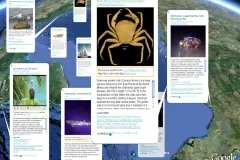What Lives in the Gulf of Mexico? Exploring Marine Collections on Google Earth

When he was 10 years old, Stephen Cairns lived in Cuba where he kept a collection of butterflies and sea shells. When his family moved to Louisiana, he could bring only one of the collections with him. He chose the shells. He says that is when he knew he was going to be a marine biologist.
Today, Dr. Cairns is a research zoologist and chair of the Invertebrate Zoology Department at the Smithsonian’s National Museum of Natural History in Washington, D.C. Recently Dr. Cairns and other scientists teamed up with the Ocean Portal to showcase examples from the marine collections on the “Explore the Ocean” layer of Google Earth, a free, interactive globe, map, and geographic information program that reaches over one-half billion users.
So far, scientists and collections staff working with the Ocean Portal team have contributed more than 200 marine stories on the layer, which is curated by Sylvia Earle's Mission Blue organization for Google Earth.
You can watch our new video for a quick tour of the Gulf collections on Google Ocean.
If you’d like to explore using Google Ocean, you’ll need to download the free Google Earth software to your computer. After you download, open Google Ocean. Click on "Ocean" under the layers tab in the left navigation, then select the "Explore the Ocean" layer. Over 100 environmental organizations, universities, scientists, photographers, and individuals have contributed to the layer.
As you move your cursor over the Gulf of Mexico, you will see that the ocean will be populated with data points which you can click on to open a small window with a marine story. Try zooming into the Gulf to see corals, deep-sea crabs, or the giant squid.
Don't leave without looking for some of the species contributed by Dr. Cairns. A deep-sea colonial coral named Lophelia pertusa and a highly invasive coral called Tubastraea micranthus are two examples of the fascinating species he has contributed to the layer. You'll find them in the northern part of the Gulf, not far from the site of the Deepwater Horizon oil platform.
____________________
Editor's Note: One of our goals is to make the Smithsonian collections more accessible to the public, and we are interested to know what you think about this new tool. If you use the Explore the Ocean layer, please tell us about your experience with Google Earth in the comment box below—was it user-friendly? Could you find the Smithsonian content and Dr. Cairns’ corals? How was this tool and information useful to you?

